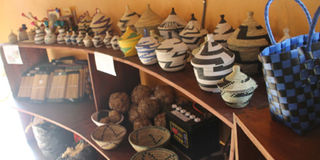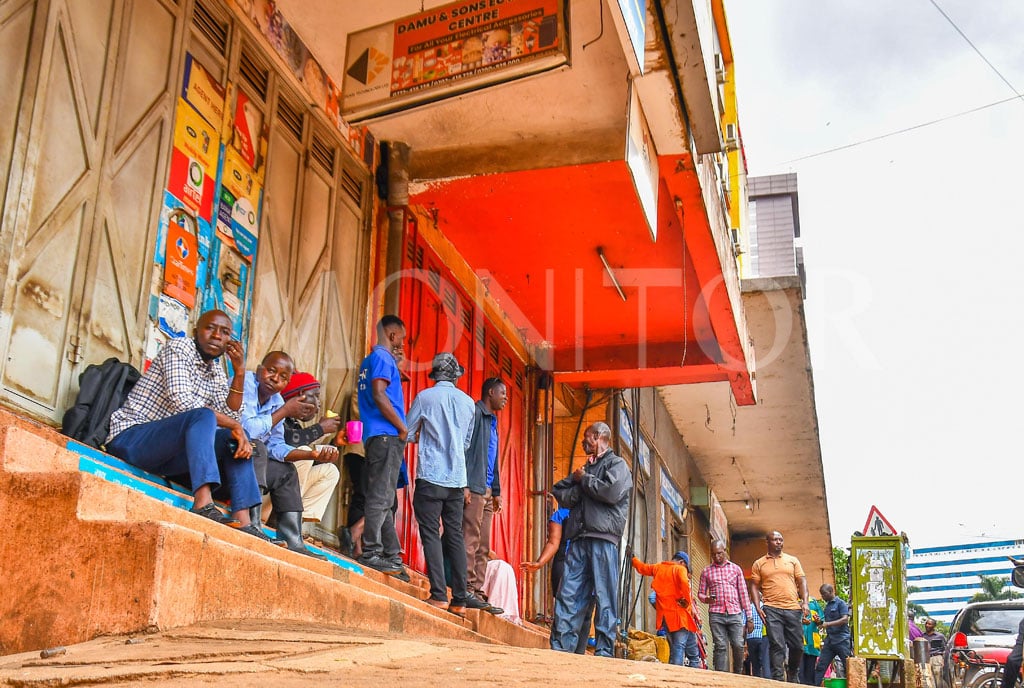Rukararwe: Where the community enhances tourism

Some of the crafts made by women under the Crafts against Poverty project of Rukararwe. Photo by Zadock Amanyisa
The beautiful Irembeezi hills landscape and a canopy of different tree species surround cottages and the green compound to create an aura of serenity.
Such is the environment at the home of Rukararwe Partnership Workshop for Rural Development (RPWRD) centre located about 4kms off Bushenyi-Kasese highway in Nyakabirizi Division, Ishaka-Bushenyi municipality.
Although it gives one an experience of nature, the eco-tourism centre is not your ordinary tourism site.
Founded in 1986 by the late Samson Nyine Bitahwa, Rukararwe was established to reduce the community dependence on donors through hosting different projects to enhance financial dependence.
The centre oversees various projects, for instance, the Crafts against Poverty (CAP), which comprises women who make handcrafts that are sold at the site. The project enables the members utilise their skills, earn a living and sustain the environment.
Another project is the Bushenyi Medical and Traditional Healers Association, which was established in 1988 as an association of traditional and western-trained healers. The association is composed of 75 healers and it operates a clinic (and a laboratory).
In touch with nature
Nicholas Kahamire, the head of forestry department, reveals that Rukararwe is also home to various bird species in the surrounding four-acre forest. All the birds can be tracked on the premises.
They include the Crested Crane, African Paradise fly catcher, Ibis, Common bulu-bulu, Sun birds, Sparrow, Hammer cop, Wood pecker, among others.
Birds such as the red and black feathered Rose Taracho can be seen when they are feeding between 11am and 2pm whereas others such as the Owl can be seen in the late evening hours or at night.
Visitors to Rukararwe also get to experience nature walks to Irembeezi hills and interact with members of the community who welcome them with the Ankole traditional dance “Ekitaguriro”.
Climbing Irembeezi hills is also said to be therapeutic to patients suffering from diabetes and high blood pressure due to the physical activity involved.
Tourists are also exposed to community activities like the process of making local brew known as Waragi and wine from bananas (eshande), Eshabwe from cow ghee, as well as preparation of Matooke and Karo with a local touch.
Colfer Humes, a german tourist at Rukararwe, says she will never forget the taste of Eshabwe with Millet bread. “I took the meal on my first dinner. I can’t stop yearning for more,” Colfer says.
Accommodation
The centre maintains an African touch even in accommodation facilities. The 12 conical cottages are representative of the traditional African hut which would be shaped like a cone. The cottages are furnished with single and double beds made from the pine tree timber.
The huts are named after animals common in Africa such as Elephant hut, Giraffe hut, Lion hut, Antelope Hut, Monkey and Zebra hut.
“It makes meaning when someone finds they are going to sleep in the Lion hut. They would want to identify themselves with the king of the jungle. Six of our cottages are unique because they have four double rooms with double bed and a single bed. This means that the centre has space for several guests or families with children.” Abby Ayebaze, the project supervisor at Rukararwe, says.
The compound is very natural, with ample space to allow one to camp under the stars in the night, and wake up to the warm sun rays.
Accommodation facilities reflect quality and affordability. Foreign and local clients pay the same amount of money. Double bed rooms go for Shs50,000 whereas singles go for Shs30,000.
Although the scenery is breathtaking, it is the food that Ayebaze boasts about. “A restaurant will serve you African dishes such as Karo (millet bread), vegetables and beans, among others which are prepared in pots,” she says.
But for those who love diversity, international dishes can be made available in the restaurant.
background to the crafts against poverty project
The CAP project started as a joint venture programme of two Ugandan NGO’s Youth Social Work Association (YSA) and Rukararwe Partnership Workshop of Rural Development.
In September 2010, the project started with an information day at Rukararwe. All interested women in the area were welcome and by the end of the day 33 of them filled their entry forms to become members of the CAP group.
The women learned how to use old papers like calendars and advertisements to produce beads for different types of jewellery such as Necklaces, bracelets and earrings.
Bracelets are sold between Shs2,000 and Shs5,000, beads, necklaces, ear rings and paper beads go for Shs2,000 - Shs1,000 depending on the quality and quantity. Glass beads are sold at Shs7,000 each. Drums cost Shs20,000 - Shs50,000.
“The quality improved a lot with time and today you can’t even realise that they are made out of paper. We also varnish them which makes them water resistant, shiny and durable. There is variety of different forms and colours in our shop on Rukararwe grounds,” says Ms Ayebaze.
The women also make music instruments such as drums, harps and shakers out of different tree species. Drums cost Shs20,000 - Shs50,000.
Rukararwe also has a traditional healers association that caters for the community’s ailments with 30 different categories of herbal medicine.




